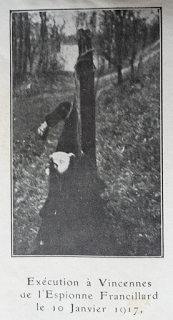The famous painting by Francisco Goya The Third of May 1808. Note the dark sky: it is a detail that Goya caught by being, probably, an eyewitness of this kind of executions. It was a tradition execute people at dawn, in nearly complete darkness. That was also what the sky looked like when Mata Hari was shot in Paris on Oct 15th, 1917 at 6:30 a.m (solar time).
I had not realized the role of darkness in executions by firing squads until the centennial of the death of Mata Hari, when I tried to be exactly in the place and at the time, in Paris, when she had been shot, one hundred years before. I tried to walk there, in the woods of the Park of Vincennes, but it was impossible for me to get there; it was just too dark. I had to wait for sunrise, about one hour later. Later on, the famous Goya painting of an execution came to my mind. I went looking for it and, yes, it was the same dark sky that I had seen in Paris at the moment of the day when Mata Hari had been shot.
This discovery opened new perspectives for me. One is that it explains why there are many pictures of people shot by firing squads during the first world war, but in most cases, we see only the dead body. Never, as far as I can say, we see the victim standing, ready to be killed. There is a logic in this: taking pictures in the near darkness at dawn must have been too much for the photographic film of the time. An example is the photo below of Marguerite Francillard, a woman shot in Vincennes in 1917, probably in the same place where Mata Hari was shot.
Assuming that Francillard was shot at dawn, as it was the use, this picture must have been taken at least half an hour after her death. Otherwise, there wouldn't have been enough light. (I know, it is ghastly, and poor Marguerite was probably innocent, but it is history)
Then, knowing that executions were carried out in darkness can help us identify what's real and what's fake among many pretended authentic pictures. For instance, look at the picture below:
In this case, we know that it is not a real picture of the execution, it is taken from a 1931 movie. But if you didn't know that, you might imagine that it shows the real execution of 1917. All the details are right: the firing squad, the hill, the dress that Mata Hari wears. But the light is just not right: this picture was taken at least at mid-morning, not at dawn. The same consideration can rule out many fake photos of the execution of Mata Hari.
But the most interesting thing about the idea of carrying out executions in darkness is darkness itself. These executions were not "justice", they were dark rituals; modern versions of human sacrifices carried out to appease the Gods of war. Today, it seems that these dark Gods are not around anymore. Maybe they are dead but, maybe, they are just sleeping, ready to wake up and restart to ask for more human sacrifices. And many human beings will probably be more than happy to sate the Gods' lust for blood.




I thinks it is "Gods' lust for war" since you were talking about the Gods of war
ReplyDelete